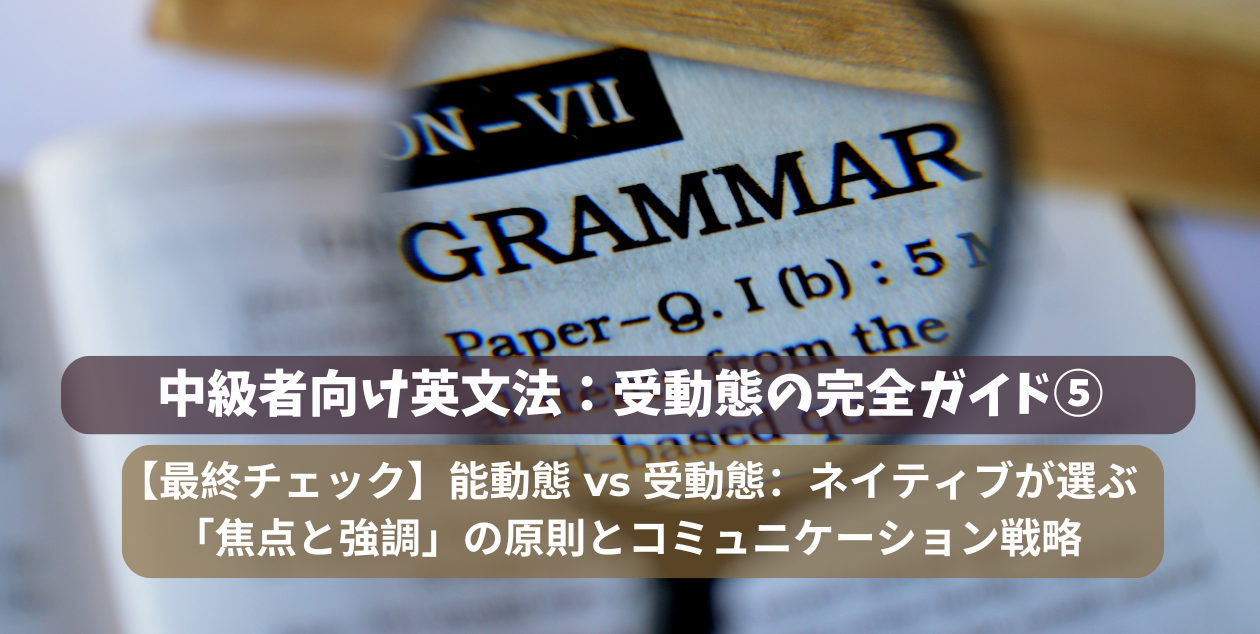海外の大学や国際的な環境で学ぶ際、試験や成績に関する英語表現は絶対に覚えておきたい必須フレーズです。「期末試験の結果はいつ発表されるの?」「成績評価の基準がよく分からない」そんな疑問を英語で的確に表現できますか?
本記事では、試験・評価・成績発表に関する重要な英語表現80選を、発音記号、詳しい解説、実用的な例文とともに完全網羅します。これらの表現をマスターすれば、海外での学習がより充実したものになるでしょう。
1. 基本的な試験用語

1.1 主要な試験タイプ
midterm
- 発音記号: /ˈmɪdtɜːrm/
- 意味: 中間試験。学期の中間に行われる主要なテスト。学習の進捗を確認する重要な評価
- 例文: “The midterm will cover chapters 1 to 5.”
- 和訳: 「中間試験は第1章から第5章までが範囲です。」
final (exam)
- 発音記号: /ˈfaɪnl/
- 意味: 期末試験。 学期の最後に行われる総合テスト。通常、成績への影響が最も大きい
- 例文: “Our final exam is scheduled for next Friday.”
- 和訳: 「期末試験は来週の金曜日に予定されています。」
quiz
- 発音記号: /kwɪz/
- 意味: 小テスト。授業中やオンラインで行われる短いテスト。理解度の確認に使用
- 例文: “There will be a quiz at the beginning of each class.”
- 和訳: 「毎回の授業の最初に小テストがあります。」
exam
- 発音記号: /ɪɡˈzæm/
- 意味: 試験。学力や理解度を測るためのテスト全般を指す包括的な用語
- 例文: “The exam was more difficult than I expected.”
- 和訳: 「試験は思っていたより難しかったです。」
test
- 発音記号: /tɛst/
- 意味: テスト。知識や能力を測るための短い試験。quizよりもやや正式
- 例文: “We have a vocabulary test every Friday.”
- 和訳: 「毎週金曜日に語彙テストがあります。」
assessment
- 発音記号: /əˈsɛsmənt/
- 意味: 評価、査定。 学生の学力や理解度を測るための総合的な評価プロセス
- 例文: “Continuous assessment is used instead of a final exam.”
- 和訳: 「期末試験の代わりに継続的評価が用いられています。」
1.2 試験結果に関する基本用語
score
- 発音記号: /skɔːr/
- 意味: 得点、スコア。テストや試験で得た具体的な点数
- 例文: “My score on the final was 92 out of 100.”
- 和訳: 「期末試験の得点は100点中92点でした。」
result
- 発音記号: /rɪˈzʌlt/
- 意味: 結果、成績発表。試験や評価の結果。合否や点数を含む総合的な結果
- 例文: “The exam results will be posted online next week.”
- 和訳: 「試験結果は来週オンラインで発表されます。」
mark
- 発音記号: /mɑːrk/
- 意味: 点数、採点する。主に英国英語で使用される成績や点数を指す用語
- 例文: “My mark on the quiz was higher than I expected.”
- 和訳: 「クイズの点数は思ったより高かったです。」
2. 成績評価に関する表現

2.1 基本的な成績用語
grade
- 発音記号: /ɡreɪd/
- 意味: 成績、点数。テストや課題、授業全体の評価(A, B, C, D, F など)
- 例文: “I got a good grade on my midterm.”
- 和訳: 「中間試験で良い成績を取りました。」
GPA (Grade Point Average)
- 発音記号: /ˌdʒiː piː ˈeɪ/
- 意味: 平均成績(GPA)。全科目の成績を数値化して平均したもの。奨学金や進学に重要
- 例文: “You need a high GPA to graduate with honors.”
- 和訳: 「優等で卒業するには高いGPAが必要です。」
letter grade
- 発音記号: /ˈletər ɡreɪd/
- 意味: レターグレード(A, B, C, D, F)。アメリカの大学で一般的な成績評価方式
- 例文: “A B is considered a good letter grade.“
- 和訳: 「Bは良いレターグレードと見なされます。」
percentage grade
- 発音記号: /pərˈsɛntɪdʒ ɡreɪd/
- 意味: パーセンテージ評価。100点満点中の得点率で評価する方法
- 例文: “A percentage grade of 90% or above is usually an A.”
- 和訳: 「90%以上のパーセンテージ評価は通常Aです。」
2.2 合格・不合格に関する表現
pass
- 発音記号: /pæs/
- 意味: 合格する。試験や科目に合格すること
- 例文: “You need at least 65% to pass this class.”
- 和訳: 「このクラスに合格するには最低65%が必要です。」
fail
- 発音記号: /feɪl/
- 意味: 不合格になる。試験や科目に合格できないこと
- 例文: “If you fail the final, you have to retake the course.”
- 和訳: 「期末試験に落ちたら、その科目を再履修しなければなりません。」
pass/fail
- 発音記号: /pæs/feɪl/
- 意味: 合格/不合格(パス/フェイル)。A~Fではなく合格・不合格で評価する制度
- 例文: “This course is graded on a pass/fail basis.”
- 和訳: 「この科目はパス/フェイル評価です。」
retake
- 発音記号: /ˌriːˈteɪk/
- 意味: 再受験、再履修。不合格の場合にもう一度試験や科目を受けること
- 例文: “Students who fail can retake the exam next semester.”
- 和訳: 「不合格になった学生は来学期に再受験できます。」
3. 試験の種類と形式

3.1 特別な試験形式
make-up exam
- 発音記号: /ˈmeɪk ʌp ɪɡˈzæm/
- 意味: 追試。欠席した試験の代わりに受ける試験
- 例文: “If you miss the final, you can take a make-up exam.”
- 和訳: 「期末試験を欠席した場合は追試を受けられます。」
3.2 試験関連の場所と環境
exam venue
- 発音記号: /ɪɡˈzæm ˈvɛnjuː/
- 意味: 試験会場。試験が行われる場所
- 例文: “The exam venue is the main lecture hall.”
- 和訳: 「試験会場はメインの講義室です。」
exam paper
- 発音記号: /ɪɡˈzæm ˈpeɪpər/
- 意味: 試験用紙。試験で使用される問題用紙
- 例文: “Please write your name on the exam paper.”
- 和訳: 「試験用紙に名前を書いてください。」
4. 成績評価システムと方法

4.1 評価方法に関する用語
curve (grading on a curve)
- 発音記号: /kɜːrv/
- 意味: 相対評価。クラス全体の成績分布に合わせて評価を調整する方法
- 例文: “The professor grades the exams on a curve.”
- 和訳: 「教授は試験を相対評価で採点します。」
weighted grading
- 発音記号: /ˈweɪtɪd ˈɡreɪdɪŋ/
- 意味: 重み付け評価。課題やテストごとに成績への影響度を変える評価方法
- 例文: “The final exam has the highest weighted grading.”
- 和訳: 「期末試験が最も重み付けされています。」
point system
- 発音記号: /pɔɪnt ˈsɪstəm/
- 意味: ポイント制。各課題やテストに点数を割り当て、合計点で評価する方法
- 例文: “Our class uses a point system for grading.”
- 和訳: 「私たちのクラスはポイント制で成績をつけています。」
grading rubric
- 発音記号: /ˈɡreɪdɪŋ ˈruːbrɪk/
- 意味: 評価基準表。採点や評価の基準を示した表
- 例文: “Check the grading rubric before submitting your assignment.”
- 和訳: 「課題を提出する前に評価基準表を確認しましょう。」
4.2 成績システムに関する表現
grading system
- 発音記号: /ˈɡreɪdɪŋ ˈsɪstəm/
- 意味: 成績評価制度。成績を評価するためのシステムや方法
- 例文: “Our university uses a letter grading system.“
- 和訳: 「私たちの大学はレターグレード制度を使っています。」
grade scale
- 発音記号: /ɡreɪd skeɪl/
- 意味: 成績評価基準。成績を評価するための基準や尺度
- 例文: “The grade scale ranges from A to F.”
- 和訳: 「成績評価基準はAからFまでです。」
grade distribution
- 発音記号: /ɡreɪd ˌdɪstrɪˈbjuːʃən/
- 意味: 成績分布。クラス全体の成績の分布状況
- 例文: “The professor showed the grade distribution after the exam.”
- 和訳: 「教授は試験後に成績分布を示しました。」
5. 試験に関する重要な名詞句

5.1 スケジュールと報告書
exam schedule
- 発音記号: /ɪɡˈzæm ˈskedʒuːl/
- 意味: 試験日程。試験が行われる日時の予定
- 例文: “The exam schedule will be posted next week.”
- 和訳: 「試験日程は来週発表されます。」
grade report
- 発音記号: /ɡreɪd rɪˈpɔːrt/
- 意味: 成績報告書。学生の成績をまとめた報告書
- 例文: “You can check your grade report online.”
- 和訳: 「成績報告書はオンラインで確認できます。」
exam results
- 発音記号: /ɪɡˈzæm rɪˈzʌlts/
- 意味: 試験結果。試験の合否や点数の結果
- 例文: “The exam results will be announced tomorrow.”
- 和訳: 「試験結果は明日発表されます。」
grade point average
- 発音記号: /ɡreɪd pɔɪnt ˈævərɪdʒ/
- 意味: 平均成績点(GPA)。全科目の成績を数値化して平均したもの
- 例文: “Maintaining a high grade point average is important.”
- 和訳: 「高いGPAを維持することは重要です。」
6. 試験関連の動詞句

6.1 試験を受ける・合格する
take an exam
- 発音記号: /teɪk ən ɪɡˈzæm/
- 意味: 試験を受ける。試験に参加して問題を解くこと
- 例文: “I have to take an exam tomorrow.”
- 和訳: 「明日試験を受けなければなりません。」
pass an exam
- 発音記号: /pæs ən ɪɡˈzæm/
- 意味: 試験に合格する。試験に合格すること
- 例文: “She passed the midterm exam.”
- 和訳: 「彼女は中間試験に合格しました。」
fail an exam
- 発音記号: /feɪl ən ɪɡˈzæm/
- 意味: 試験に不合格になる。試験に合格できないこと
- 例文: “He failed the final exam.”
- 和訳: 「彼は期末試験に不合格でした。」
retake an exam
- 発音記号: /ˌriːˈteɪk ən ɪɡˈzæm/
- 意味: 試験を再受験する。不合格や欠席の場合に試験をもう一度受けること
- 例文: “If you fail, you can retake the exam next semester.”
- 和訳: 「不合格の場合は来学期に試験を再受験できます。」
6.2 試験準備と提出
study for an exam
- 発音記号: /ˈstʌdi fɔːr ən ɪɡˈzæm/
- 意味: 試験勉強をする。試験に備えて勉強すること
- 例文: “I need to study for the final exam.”
- 和訳: 「期末試験のために勉強しなければなりません。」
submit a test paper
- 発音記号: /səbˈmɪt ə tɛst ˈpeɪpər/
- 意味: 試験用紙を提出する。試験終了後に解答用紙を提出すること
- 例文: “Please submit your test paper to the invigilator.”
- 和訳: 「試験監督に試験用紙を提出してください。」
6.3 成績確認と評価
check your grade
- 発音記号: /tʃɛk jʊər ɡreɪd/
- 意味: 成績を確認する。自分の成績を確認すること
- 例文: “You can check your grade online.”
- 和訳: 「成績はオンラインで確認できます。」
receive a grade
- 発音記号: /rɪˈsiːv ə ɡreɪd/
- 意味: 成績を受け取る。試験や課題の評価を受け取ること
- 例文: “Students will receive their grades next week.”
- 和訳: 「学生は来週成績を受け取ります。」
appeal a grade
- 発音記号: /əˈpiːl ə ɡreɪd/
- 意味: 成績の再評価を申し立てる。成績に不満がある場合に再評価を求めること
- 例文: “I want to appeal my grade on the final exam.”
- 和訳: 「期末試験の成績について再評価を申し立てたいです。」
grade on a curve
- 発音記号: /ɡreɪd ɒn ə kɜːrv/
- 意味: 相対評価で採点する。クラス全体の成績分布に基づいて評価を調整すること
- 例文: “The professor grades the exams on a curve.”
- 和訳: 「教授は試験を相対評価で採点します。」
7. 成績の理由を説明する表現

7.1 原因を説明する表現
due to
- 発音記号: /duː tuː/
- 意味: ~が理由で。成績や評価の原因を述べるときに使う前置詞句
- 例文: “My grade was lower due to several missed assignments.”
- 和訳: 「いくつか課題を提出しなかったため、成績が下がりました。」
because of
- 発音記号: /bɪˈkʌz ʌv/
- 意味: ~のため。理由や原因を説明するときに使う前置詞句
- 例文: “She received a high grade because of her excellent presentation.”
- 和訳: 「彼女は素晴らしい発表をしたため高い成績をもらいました。」
as a result of
- 発音記号: /æz ə rɪˈzʌlt ʌv/
- 意味: ~の結果として。結果や影響を述べるときに使う表現
- 例文: “He failed the quiz as a result of not studying.”
- 和訳: 「彼は勉強しなかった結果、クイズに落ちました。」
7.2 減点・加点を説明する表現
was/were marked down for
- 発音記号: /wəz/wɜːr mɑːrkt daʊn fɔːr/
- 意味: ~のため減点された。減点や評価が下がった理由を述べるときに使う
- 例文: “I was marked down for not following the instructions.”
- 和訳: 「指示に従わなかったため減点されました。」
was/were given extra credit for
- 発音記号: /wəz/wɜːr ˈɡɪvən ˈekstrə ˈkrɛdɪt fɔːr/
- 意味: ~のため加点された。プラス評価や加点の理由を述べるときに使う
- 例文: “She was given extra credit for participating in class discussions.”
- 和訳: 「彼女は授業のディスカッションに参加したことで加点されました。」
was/were penalized for
- 発音記号: /wəz/wɜːr ˈpiːnəlaɪzd fɔːr/
- 意味: ~のため減点された、ペナルティを受けた。規則違反や遅延などによる減点を説明するときに使う
- 例文: “My assignment was penalized for late submission.”
- 和訳: 「課題は提出遅れで減点されました。」
7.3 成績の根拠を説明する表現
the main reason for my grade was
- 発音記号: /ðə meɪn ˈriːzən fɔːr maɪ ɡreɪd wəz/
- 意味: 成績の主な理由は~だった。成績や評価の根拠を説明する際の定型表現
- 例文: “The main reason for my grade was the lack of supporting evidence.”
- 和訳: 「成績の主な理由は証拠が不足していたことです。」
my grade reflects
- 発音記号: /maɪ ɡreɪd rɪˈflɛkts/
- 意味: 私の成績は~を反映している。成績や評価がどのような努力や成果を反映しているか説明するときに使う
- 例文: “My grade reflects my improvement over the semester.”
- 和訳: 「私の成績は学期中の成長を反映しています。」
according to the grading rubric
- 発音記号: /əˈkɔːrdɪŋ tuː ðə ˈɡreɪdɪŋ ˈruːbrɪk/
- 意味: 評価基準によれば。採点や評価が基準に基づいていることを説明する際に使う
- 例文: “According to the grading rubric, organization is worth 20% of the grade.”
- 和訳: 「評価基準によれば、構成は成績の20%を占めます。」
8. 評価基準表(ルーブリック)関連表現

8.1 ルーブリックの基本要素
criterion / criteria
- 発音記号: /kraɪˈtɪəriən/(単数) /kraɪˈtɪəriə/(複数)
- 意味: 評価基準、採点項目。学生の課題やパフォーマンスを評価する際の具体的な観点や要素
- 例文: “The main criteria for this essay are organization, clarity, and use of evidence.”
- 和訳: 「このエッセイの主な評価基準は構成、明確さ、証拠の活用です。」
levels of performance
- 発音記号: /ˈlevəlz əv pərˈfɔːrməns/
- 意味: 達成度の段階。各評価基準に対してどの程度達成できているかを示す段階
- 例文: “Each criterion is assessed at different levels of performance, such as Excellent or Satisfactory.”
- 和訳: 「各評価基準は、優秀・満足・改善が必要などの達成度で評価されます。」
descriptor / description
- 発音記号: /dɪˈskrɪptər/ /dɪˈskrɪpʃən/
- 意味: 説明文、評価内容。各達成度レベルで期待される具体的な行動や成果を記述したもの
- 例文: “The descriptor for ‘Excellent’ in organization is ‘Ideas are logically sequenced and easy to follow.'”
- 和訳: 「構成の『優秀』の説明文は『アイデアが論理的に並び、わかりやすい』です。」
8.2 評価の重み付けと尺度
weight / weighting
- 発音記号: /weɪt/ /ˈweɪtɪŋ/
- 意味: 重み付け。各評価基準が全体の成績にどれだけ影響するかを示す割合
- 例文: “Organization counts for 20% of the total score according to the rubric weighting.”
- 和訳: 「評価基準表によると構成は全体の20%を占めます。」
rating scale
- 発音記号: /ˈreɪtɪŋ skeɪl/
- 意味: 評価尺度。各基準の達成度を示すための段階(例:4=Excellent, 3=Good, 2=Fair, 1=Poor)
- 例文: “The rating scale ranges from 1 (Needs Improvement) to 4 (Excellent).”
- 和訳: 「評価尺度は1(改善が必要)から4(優秀)までです。」
indicator
- 発音記号: /ˈɪndɪˌkeɪtər/
- 意味: 指標、具体例。各レベルでの達成度を判断するための具体的な行動や成果の例
- 例文: “Indicators for ‘Clarity’ include correct grammar and clear sentence structure.”
- 和訳: 「明確さの指標には正しい文法や明瞭な文構造が含まれます。」
rubric description
- 発音記号: /ˈruːbrɪk dɪˈskrɪpʃən/
- 意味: ルーブリック説明文。どの項目をどのように評価するかを学生に伝える説明文
- 例文: “The rubric description explains what will be assessed and how.”
- 和訳: 「ルーブリック説明文は、何がどのように評価されるかを説明します。」
8.3 具体的な評価項目の例
評価項目を説明する際によく使われるフレーズ:
Content (内容)
- “Does the work fully address the assignment and demonstrate understanding of the topic?”
- 和訳: 「内容:課題に十分に取り組み、トピックを理解しているか?」
Organization (構成)
- “Are ideas logically sequenced and easy to follow?”
- 和訳: 「構成:アイデアが論理的に並び、分かりやすいか?」
Evidence (証拠)
- “Is there sufficient supporting evidence and are sources properly cited?”
- 和訳: 「証拠:十分な裏付けがあり、出典が正しく示されているか?」
Mechanics (文法・表記)
- “Is the work free from spelling and grammatical errors?”
- 和訳: 「文法・表記:スペルや文法のミスがないか?」
Creativity (独自性)
- “Does the work show originality and creative thinking?”
- 和訳: 「独自性:独創性や創造的な思考が見られるか?」
Use of sources (資料の活用)
- “Are sources relevant, reliable, and integrated effectively?”
- 和訳: 「資料の活用:資料が適切で信頼でき、効果的に活用されているか?
8.4 rubricの項目例を説明するフレーズ
- Exemplary / Excellent: “Work exceeds all expectations and demonstrates mastery.”
和訳: 「優秀:期待をすべて上回り、習熟度が示されている。」 - Proficient / Good: “Work meets the assignment requirements and shows solid understanding.”
和訳: 「良好:課題の要件を満たし、十分な理解を示している。」 - Developing / Satisfactory: “Work meets some requirements but needs improvement in certain areas.”
和訳: 「発展途上:一部の要件は満たしているが、改善が必要な点がある。」 - Needs Improvement / Inadequate: “Work does not meet the basic requirements and lacks clarity or detail.”
和訳: 「改善が必要:基本的な要件を満たしておらず、明確さや詳細が不足している。」
会話例

学生同士の会話
Maya: Hey, Alex! Did you check your grade report for the midterm?
Alex: Yeah, I did. I got a B, which isn’t bad, but I was hoping for an A. The grading rubric said organization was worth 20% of the grade, and I think I lost points there.
Maya: I know what you mean. I got a C on the quiz last week, but luckily it’s only a small part of the assessment. Are you worried about the final exam?
Alex: Definitely! The final is 40% of our total grade. I heard the professor might grade on a curve this time because the last exam results were pretty low.
Maya: That would help! By the way, do you know the exam schedule for finals week?
Alex: Yeah, it’s posted online. Our final is next Thursday in the main lecture hall. If you miss it, you have to take a make-up exam.
Maya: I really hope I pass. I need at least a B to keep my GPA high enough for my scholarship.
Alex: Same here. If I fail the final, I’ll have to retake the exam next semester. Let’s study together this weekend!
Maya: Great idea! Let’s review the grading rubric before we start so we know what to focus on.
マヤ:ねえアレックス!中間試験(midterm)の成績報告書(grade report)見た?
アレックス:うん、見たよ。Bだったから悪くはないけど、Aを狙ってたんだ。評価基準表(grading rubric)によると構成が成績の20%を占めてて、そこで減点されたみたい。
マヤ:分かるよ。私は先週の小テスト(quiz)がCだったけど、全体の評価(assessment)では小さい割合だからまだ良かった。期末試験(final exam)は心配?
アレックス:もちろん!期末試験(final)は成績の40%だし。教授が今回は相対評価(grade on a curve)にするかもって聞いたよ。前回の試験結果(exam results)がかなり低かったから。
マヤ:それは助かるね!ちなみに、期末試験のスケジュール(exam schedule)知ってる?
アレックス:うん、オンラインに載ってるよ。僕たちの*期末試験(final)は来週木曜、メイン講義室だって。もし欠席したら追試(make-up exam)を受けなきゃいけない。
マヤ:絶対合格したいな。B以上取らないとGPAが下がって奨学金が危ないから。
アレックス:僕も同じ。もし期末試験(final)に落ちたら、来学期に再受験(retake the exam)だよ。今週末一緒に勉強しよう!
マヤ:いいね!始める前に評価基準表(grading rubric)を確認して、重点を絞ろう。
TAと学生の会話
Student (Liam): Hi, are you the TA for this course?
TA (Rachel): Yes, I am. How can I help you?
Liam: I just checked my grade report for the midterm, and I was surprised by my score. Could you explain how the grading rubric was applied?
Rachel: Of course! The grading rubric breaks down the assessment into content, organization, and use of evidence. For the midterm, content was 50%, organization 30%, and evidence 20%. If you want, I can go over your exam with you in detail.
Liam: That would be great. Also, I missed the last quiz because I was sick. Is it possible to take a make-up exam?
Rachel: Yes, you can take a make-up quiz next week. Just email me your availability, and I’ll schedule it.
Liam: Thank you! One more thing—how much does the final exam affect my overall grade?
Rachel: The final is 40% of your total grade. Also, the professor sometimes grades on a curve if the class average is low.
Liam: I see. I really want to keep my GPA high enough for my scholarship, so I’ll study hard for the final.
Rachel: That’s a good plan. If you need help reviewing or have questions about the assessment, come to my office hours.
Liam: Thanks so much, Rachel. I appreciate your help!
学生(リアム):こんにちは。このコースのTAさんですか?
TA(レイチェル):はい、そうです。どうしましたか?
リアム:中間試験(midterm)の成績報告書(grade report)を見たんですが、点数に驚いてしまって。評価基準表(grading rubric)がどう適用されたのか説明してもらえますか?
レイチェル:もちろんです!評価基準表(grading rubric)は、内容・構成・証拠の使い方で評価を分けています。中間試験(midterm)は内容が50%、構成が30%、証拠が20%です。希望があれば、試験の内容を一緒に詳しく見直しましょう。
リアム:ぜひお願いします。それと、先週の小テスト(quiz)を病気で受けられなかったんですが、追試(make-up exam)は可能ですか?
レイチェル:はい、来週追試(make-up quiz)が受けられます。都合の良い日時をメールで送ってくれれば、スケジュールを調整します。
リアム:ありがとうございます!もう一つ、期末試験(final exam)は全体の成績(grade)にどれくらい影響しますか?
レイチェル:期末試験(final)は全体の40%です。それに、クラス平均が低い場合は教授が相対評価(grade on a curve)にすることもあります。
リアム:分かりました。奨学金のためにもGPAを高く保ちたいので、期末試験(final)はしっかり勉強します。
レイチェル:それが一番ですね。復習のサポートや評価(assessment)について質問があれば、オフィスアワーに来てください。
リアム:本当にありがとうございます、レイチェル。助かりました!
Guide for New Students: Exams and Assessmentを読んでみましょう!

Guide for New Students: Exams and Assessment
1. Types of Exams and How They Work
- Midterm, final, and quiz are the most common types of exams at university.
- Midterm: Held in the middle of the semester to assess your progress.
- Final exam: Usually at the end of the semester and often counts for a large portion of your final grade.
- Quiz: Short tests given throughout the semester to check your understanding of recent material.
- Exams can be delivered in different ways:
- Face-to-face (paper or computer lab on campus)
- Supervised online exams
- School-run exams
Always check your exam schedule and location in advance. Bring your student ID and only permitted items (e.g., stationery, water in a clear bottle).
2. Exam Preparation and Strategies
- Review your course outline, lecture notes, and key concepts from readings.
- Make a study plan and manage your time before the exam.
- Practice with past exams or sample questions if available.
- On exam day, arrive early, bring everything you need, and stay calm.
- During the exam:
- Read all instructions carefully.
- Manage your time wisely—don’t spend too long on one question.
- If you finish early, check your answers for mistakes or missed questions.
3. Grading and Evaluation
- Your performance is assessed using a grading system (e.g., letter grades A–F, number grades, or pass/fail).
- Each exam or assignment may have a different weight toward your final grade (for example, the final exam may count for 40%).
- GPA (Grade Point Average) is calculated from your grades in all courses and is important for scholarships and graduation.
- Some courses use a grading rubric to show how your answers will be evaluated (e.g., content, organization, use of evidence).
- Grades may be adjusted using a curve if the class average is low.
4. After the Exam
- Grade reports or exam results are usually posted online.
- If you miss an exam for a valid reason, you may be able to take a make-up exam.
- If you do not understand your grade or believe there is a mistake, you can ask for an explanation or appeal the grade.
- Use feedback from your exams to improve your study strategies for next time.
5. Important Rules and Tips
- Follow all exam rules: No cheating, no unauthorized materials, and no talking during the exam.
- Keep your phone and smart devices off and stored away.
- Respect the exam environment and other students.
- If you have a Learning Access Plan or need special accommodations, arrange this with your school in advance.
新入生向けガイド:試験と評価
1. T試験の種類と仕組み
- 大学では中間試験(midterm)、期末試験(final)、小テスト(quiz)が一般的です。
- 中間試験:学期の中頃に進捗を測るために実施されます。
- 期末試験:学期末に実施され、最終成績への比重が大きいことが多いです。
- 小テスト:学期中に何度も行われ、最近学んだ内容の理解度を確認します。
- 試験の実施方法は様々です。
- 対面式(紙またはコンピュータラボで実施)
- 監督付きオンライン試験
- 学部・学科独自の試験
試験日程や会場は必ず事前に確認し、学生証や必要な持ち物を忘れずに持参しましょう。
2. 試験準備と受験のコツ
- コース概要や講義ノート、教科書の重要ポイントを復習しましょう。
- 試験前に計画を立てて勉強時間を管理しましょう。
- 過去問やサンプル問題があれば活用しましょう。
- 試験当日は早めに到着し、落ち着いて臨みましょう。
- 試験中は:
- 指示をよく読みましょう。
- 時間配分に注意し、一つの問題に時間をかけすぎないようにしましょう。
- 早く終わった場合は、見直しをしてミスや未回答がないか確認しましょう。
3. 成績評価について
- 成績はレターグレード(A~F)や数値評価、パス/フェイル(pass/fail)などでつけられます。
- 各試験や課題の成績が最終成績に占める割合(重み)は異なります(例:期末試験は40%など)。
- GPA(Grade Point Average)は全科目の成績から算出され、奨学金や卒業に重要です。
- 一部の授業では評価基準表(grading rubric)が使われ、どのように採点されるかが明示されています。
- クラス平均が低い場合は相対評価(curve)が適用されることもあります。
4. 試験後の流れ
- 成績報告書(grade report)や試験結果(exam results)は通常オンラインで発表されます。
- 正当な理由で試験を欠席した場合は追試(make-up exam)が認められることがあります。
- 成績に納得できない場合や疑問がある場合は、説明を求めたり、再評価を申請したりできます。
- 試験のフィードバックを次回の学習に活かしましょう。
5. 重要なルールとアドバイス
- 試験の規則を守りましょう:カンニング禁止、許可されていないものの持ち込み禁止、試験中の私語禁止。
- スマートフォンや電子機器は電源を切り、指定の場所に保管しましょう。
- 試験会場や他の受験者への配慮を忘れずに。
- 特別な配慮(Learning Access Plan等)が必要な場合は、事前に学校に申請しましょう。
まとめ

本記事では、海外の大学生活で避けて通れない試験、評価、成績に関する重要な英語表現80選を、具体的な例文と会話例を交えてご紹介しました。
“midterm” や “final exam” といった基本的な試験の種類から、“GPA” や “grading rubric” といった成績評価システム、さらには “appeal a grade” のような具体的なアクションまで、幅広い表現を網羅しています。これらの表現をマスターすることで、「期末試験の結果はいつ発表されるの?」「成績評価の基準がよく分からない」といった疑問を英語で的確に表現できるようになります。
海外での学業を円滑に進めるためには、専門知識だけでなく、こうしたアカデミックなコミュニケーション能力が不可欠です。今回ご紹介したフレーズを積極的に活用し、自信を持って大学生活を送ってください。
皆さんの海外での学習がより充実したものになるよう、応援しています!
英語・英会話の基礎を学びたい方はこちらから! ↓

語彙力強化したい方はこちらから! ↓






















































